Post-partition drama-
By the time the British left India partitioned, the seed of an identity of qaum was sowed in the Sikhs who majorly inhabited the then state of newly formed Punjab.
Punjabi Suba Morcha-
- The Shiromani Akali Dal (SAD) was originally established as a task force to assist the Singh Sabha movement in freeing Gurudwaras from the control of mahants and returning them to the Sikhs.
- The Shiromani Akali Dal (SAD) is the oldest regional party in the country and gained national attention for its role in the Gurdwara Act 1925, which resulted in the establishment of the Shiromani Gurudwara Parbandhak Committee (SGPC) to manage historic Gurudwaras.
- The Akali Dal is unique in that it derives its political power from religion, making it the only political party in India to do so.
- But the above-mentioned notion of quam that was more or less, the base of SAD’s establishment also drove it against Hindi and eventually their speakers. During the 1950s and 1960s, the SAD initiated the ‘Punjabi Suba Morcha’, a movement demanding the formation of a Punjabi-speaking state with a Sikh majority.
Sachar Formula-
- The Sachar Formula was devised in 1949 to address the growing agitation over the language issue in Punjab.
- A team of distinguished Congress party members, comprising two Hindu and two Sikh representatives, drafted the formula with the aim of finding a resolution that would appease all concerned parties.
- The formula proposed that Punjabi be made the medium of instruction in the “Punjabi zone” area up to the matriculation stage.
- In the “Punjabi zone” area, Hindi would be taught as a compulsory subject from the end of the primary level onward.
- Conversely, in the “Hindi zone” areas, Hindi would be the medium of instruction, while Punjabi would be taught as a compulsory subject from the end of the primary level onward.
- Despite its noble intentions, the Sachar Formula was unable to entirely resolve the language issue in Punjab because the Sikhs and the Hindus of the “Punjabi zone” areas were not ready to learn Hindi. [Punjab after Independence: S.S. Bal]
Jawahar Lal Nehru rejected all ideas of a separate state. On the contrary, he merged Patiala and East Punjab States Union (PEPSU), a state of India comprising eight princely states into the then-existing state of Punjab in 1956.
The Trifurcation-
The SAD kept knocking on the doors. The methods used varied from sloganeering to namesake fasting. Mostly, violence was the favourite weapon used by the Akalis. This violence was however met with violence, mostly from Jan Sangh.
In 1966, a Parliamentary Committee submitted a report recommending the creation of a Punjabi-speaking state from the erstwhile East Punjab state. The Congress Working Committee had already adopted a motion on March 6th recommending the same to the government. The report was made public on March 18th, and the demand was accepted on April 23rd. A commission was appointed on April 17th to demarcate the new states of Punjab and Haryana, with certain areas transferred to Himachal Pradesh.
The Punjab Reorganisation Act of 1966 was passed on September 18th in the Lok Sabha, and on November 1st of the same year, Punjab as we know it today became reality. SAD, however, were displeased. They believed that the demarcation done on the basis of Tehsil instead of villages shaved many Punjabi-speaking regions into Haryana and Himachal Pradesh. Also, Chandigarh was made a Union Territory.
We gave you the historical context of Punjab and its intricately intertwined language issue. Now, we will now show you the problems.
Q. Why are we doing it?
Ans. Well because no one else will. In the urge to present our nation gleaming with the vibrancy of languages and culture, we sometimes forget that a normal walk to our ancient lanes is now magically but carefully laden with language hurdles. And in the desperate attempt to jump through these hurdles, we forget to ask ourselves simple questions- who put these hurdles here and most importantly why are we expected to jump them than remove them?
Exhibits of the problem-
It is generally argued that Punjab gets a bad reputation. However, a comprehensive study at our end indicates that this notion is unfounded. In fact, our research suggests that the extent of the troubles that Punjab causes is frequently underestimated and not adequately covered. And keep in mind that these problems are linked to Punjabis.
Exhibit A: Hijackings by Punjabis
Surprised to see this on top of this list? We have a fun fact for you – There have been more hijackings of Indian Aeroplanes by Punjabis than any other ethnicity. And for the remaining many instances of hijackings by Islamist terrorists, Punjab’s Amritsar has either provided landing permission for negotiations [maybe not so concerning] or a refuelling facility to land in Pakistan.
1. 29 September 1981: A group of 5 Sikh separatists hijacked an Indian Airline plane carrying 111 passengers and 6 crew members, demanding a separate Sikh homeland [You know the K word]. The hijackers rerouted the aircraft to Lahore, but Pakistan ensured the safety of the passengers in response to India’s request. Pakistani commandos overpowered the terrorists and rescued the passengers, leading to the hijackers’ trial and life imprisonment in Pakistan.
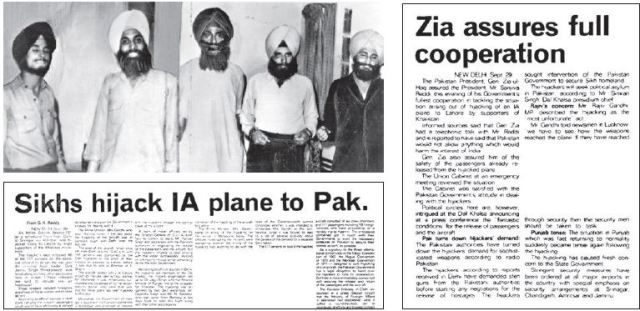
2. 4 August 1982: Gurbaksh Singh hijacked an Indian Airlines flight from Delhi-Srinagar, citing a retaliatory motive after the government prohibited Sikhs from carrying their ceremonial daggers on board. The hijacker was denied permission to land in Pakistan and landed instead in Amritsar, where he surrendered to the authorities in front of SAD general secretary (Although he demanded a surrender in front of SAD president or Bhindrawale). All passengers and crew, including 70 foreigners, were rescued successfully.
3. 22 August 1982: Another Sikh extremist hijacked an Indian Airlines plane from Mumbai to New Delhi. Armed with a pistol and a grenade, Manjit Singh rerouted the plane to Libya but ended up planning to land in Lahore due to fuel shortage. Indian authorities intervened and prevented the aircraft from landing in Pakistan, forcing it to land in Amritsar instead. Manjit Singh proposed negotiations for his release but was killed by the police during the process.
4. July 6 1984: After Operation Bluestar (We had written shortly about it in our piece Massacre 1984), the Sikhs separatists were furious with the government‘s audacious move. A group of five Sikh militants, led by Parminder Singh Saini, hijacked an aircraft bound for Delhi from Srinagar in order to avenge the death of their leader and free other separatists. The hijackers threatened to blow up the aircraft if they were not allowed to land and ultimately landed in Lahore. After a 17-hour standoff, the hijackers surrendered to Pakistani forces and were subsequently put on trial in a Lahore court.
5. 24 July 1984: In another incident, disillusioned Sikh youths attempted to bring attention to the alleged atrocities against Sikhs in India by hijacking a Chandigarh-Srinagar flight to Lahore and then Karachi, before eventually arriving in Dubai with the aim of raising awareness about the Punjab freedom struggle in the United States. UAE negotiated the release of Indian passengers in exchange for political asylum for the hijackers, but they were later deported to India and sentenced to life imprisonment. All seven hijackers were imprisoned in Ajmer, Rajasthan.
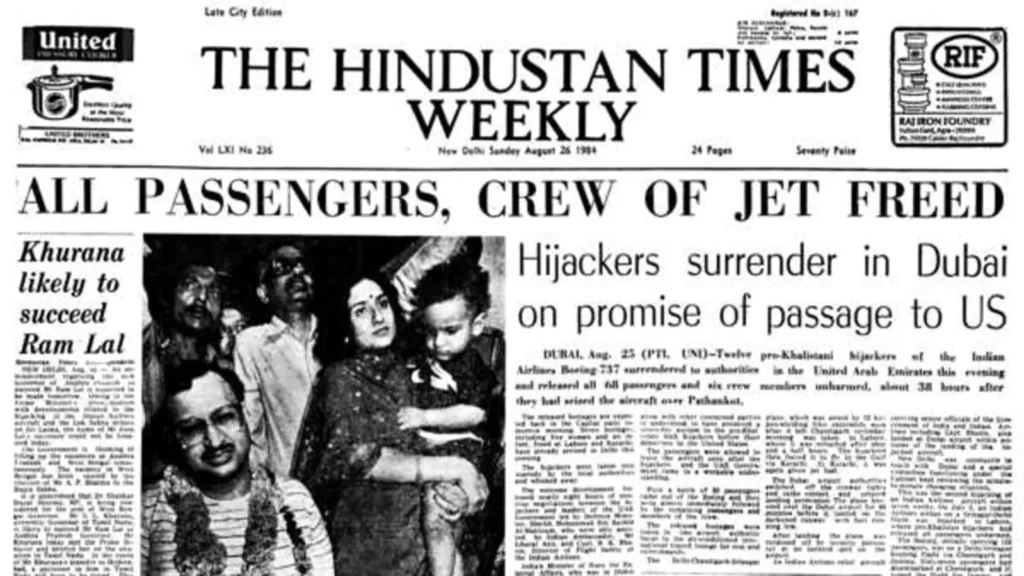
The Punjabi militants’ hijackings were a reckless pursuit of their separatist ambitions, which threatened the safety of mostly Indian passengers.
Exhibit B: Referendums for a separate state
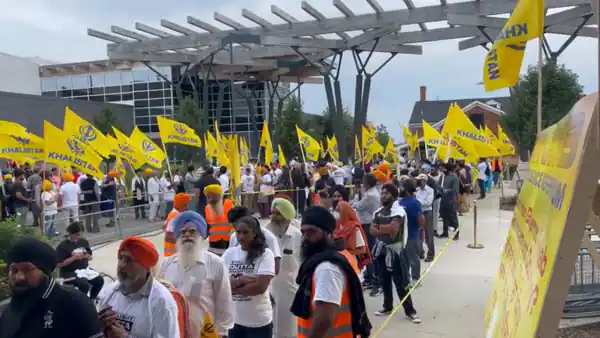
The idea of a separate nation has been a contentious issue for several decades, and it has prompted various groups to hold referendums in different parts of the world to gauge support for the cause. Places like Italy, Canada, the UK, the US, Australia, and Geneva have seen participation in lakhs of people voting in these referendums. Providing individual instances will lengthen this piece. We suggest a web search for the same. What is important is that all these referendums, despite being painted as the NRI Sikh movement, always call for Punjabis, and not just the Sikhs to vote. We request our readers to invoke the non-turbanised version of Punjabi that we discussed earlier.
Punjab Referendum 2020 is a campaign to liberate Punjab, currently occupied by India. The campaign aims to gauge the will of the Punjabi people with regards to reestablishing Punjab as a nation state. Once we establish consensus on the question of independence, we will then present the case to the United Nations for reestablishing the country of Punjab.
Source: Referendum 2020 website
Exhibit C: Attacks on Indian Embassies
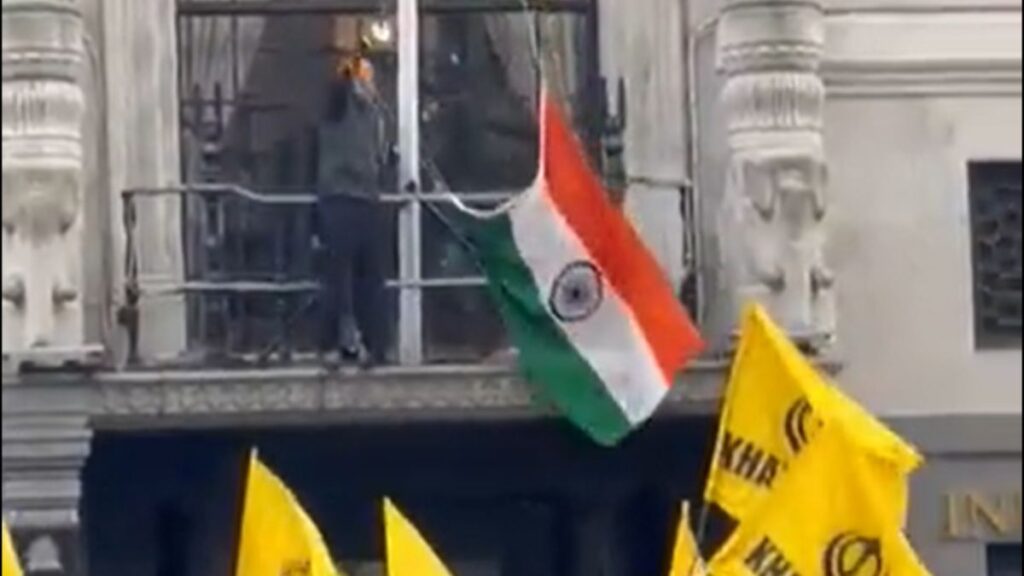
[After the screengrab, the Tricolour was saved by an Indian official]
The attacks carried out by separatists on Indian Embassies represent a misguided approach and long-nurtured hate for India. Such hate is almost impossible to express in the open in Intame. The most notorious attack by the time of writing of this piece is the closing of the Indian consulate in Brisbane due to persistent attacks and threats.
What makes these elements so fearless? The answer is multi-faceted but the prime reason is that due to the migration culture of Punjab, a Punjabi migrating outside India almost never does so to have a desk job. It is mostly the easy money in labour-oriented jobs of trucking or cab-driving or to add in the already well-established business networks of previous Punjabis.
The intentional attempt to cover their faces when on film should be a no-brainer that either they are out of Punjab on Indian passports carrying visas or they are fearful of their OCI card getting cancelled. Either way, it implies a direct and unsevered connection to Punjabis back in India. The ideals of separatism are on both sides of the border.
Exhibit D: Weapons and Drugs-
1. Punjab makes up 2% of India’s population but holds 10% of the arms license. For Punjabis, owning a firearm is not just a matter of protection, but also a matter of fashion statement. Unfortunately, this love for guns has led to a demand for illegal firearms, which are easily accessible. These illegal arms primarily come from neighbouring states like Madhya Pradesh [article] and Uttar Pradesh, as well as smuggled across the border from Pakistan through drones.
‘Pakhiyan, pakhiyan.. gun vich panj goliyaan’
Environment: The rise in the availability of arms and ammunition is fuelled by the popularity of Punjabi music videos that glorify men with guns, and include lyrics that reference firearms. Sidhu Moose Walla’s track ‘Outlaw’ is an example of this, where he sings about bullets and FIRs being like medals, and their deeds being discussed in Parliament. Celebratory firing is a common affair in Punjab with artists like Elly Mangat doing it at birthday parties. Then there are people like Sippy Gill who write tracks like ‘Gundagardi’ to promote violence and weapons. It simply fits in the equation of demand and supply.
If until any point of reading this exhibit, our readers think this as a sensationalist attempt to single out Punjab in times when contents of almost all other cultures are also glorifying guns and violence, we will leave this tweet where the state is itself accepting the gun culture.
In a bid aimed at checking gun culture & to maintain law and order, CM @BhagwantMann has ordered review of all the arm licenses & no issuance of new license in coming three months. It also has been directed that a complete ban should be imposed on songs eulogising gun culture.
— Government of Punjab (@PunjabGovtIndia) November 13, 2022
2. It is not hidden that Punjab has a drug problem. It doesn’t matter if you are rich or poor, male or female, young or old, Sikh or Hindu, if you are Punjabi then you have witnessed death due to drug abuse either directly or indirectly. The situation is so dire that there are now villages of widows, such as Maqboolpura, where all the men have died due to drug addiction. The popular drugs are Opioids (Heroin) and Buprenorphine.
Fun but not so surprising fact: 99% of all Opioid abusers speak Punjabi.
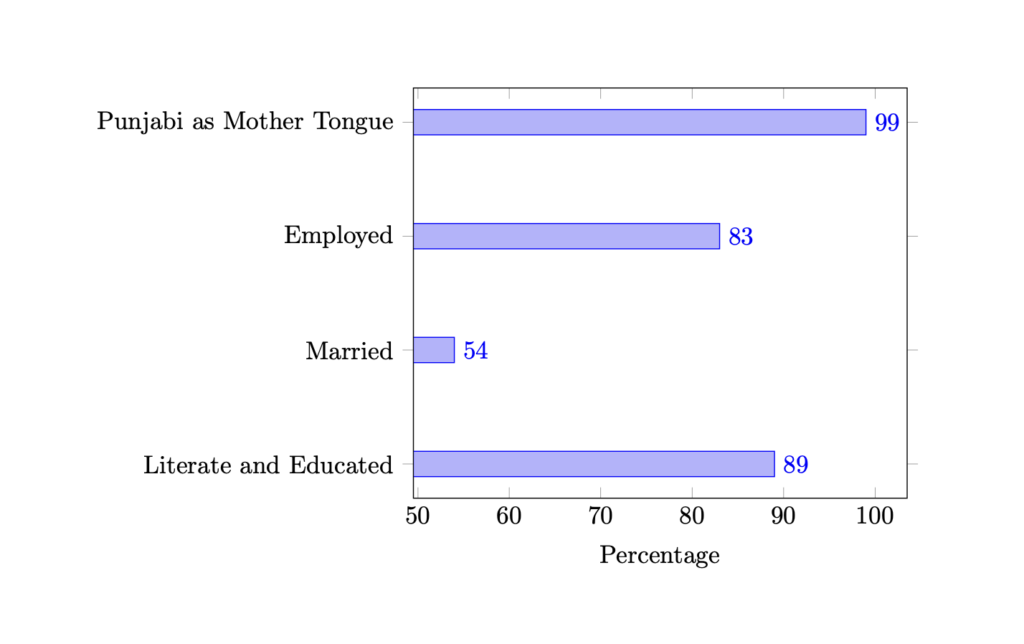
In a survey conducted by India Institute and SPYM (Society for Promotion of Youth and Masses) in collaboration with NDDTC AIIMS, out of 2.32 lakhs drug abusers, 69.9% were doing it for fun and 43.9% were doing it under peer pressure. This is enough evidence to suggest that this is not a socioeconomic but indeed a cultural problem.
Again, if this data is mistaken by anyone as an attempt to villainise Punjabis, we ask you to bring to us any other village in India outside Punjab, where an entire village has lost all males to drugs. Further, here is our compilation of how Punjab fares on a national scale in terms of the consumption of narcotics.
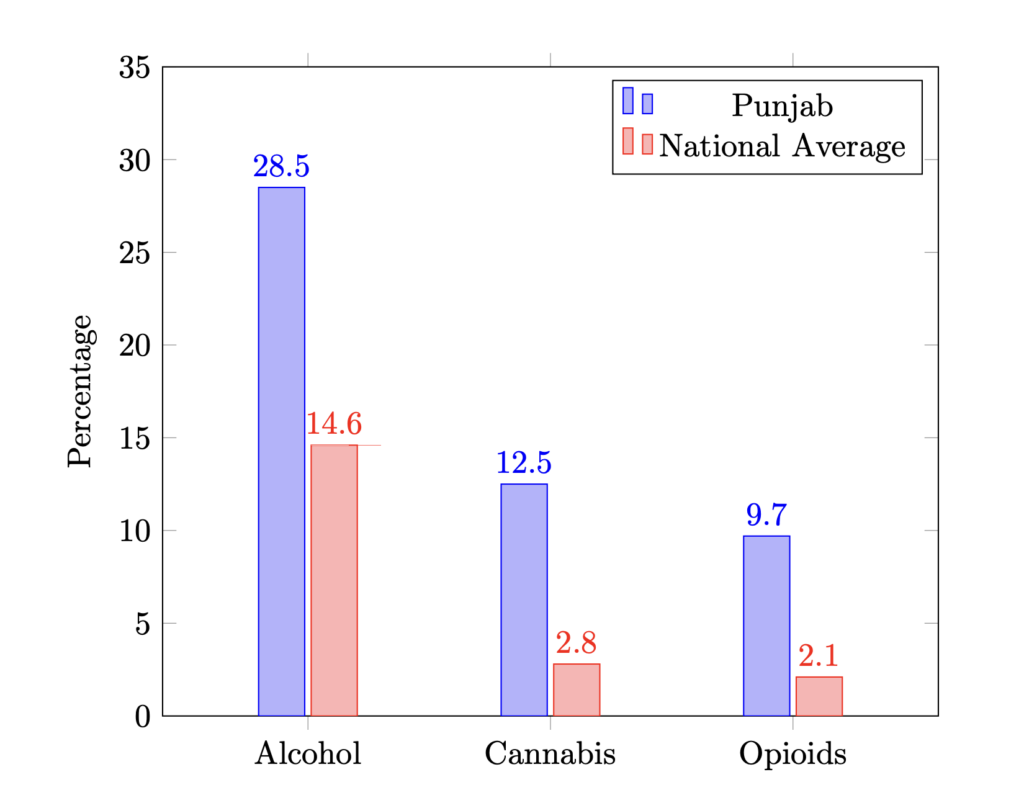
Supply: Cross-border drones are getting popular to supply both weapons and drugs to Punjabis. [article] Some of these weapons are then supplied to the militants in Kashmir. In the hunger for guns and heroine, Punjabis are allowing the country’s money to flow to Pakistan which is also getting aerial surveillance footage of the Indian side as a byproduct. We have already sustained one such drone attack in J&K. The foreign connections of Punjabis provide for smooth cash-flow in and out of the country.
Drone sightings in Punjab were 47 in 2020, 64 in 2021 and 260+ in 2022. These increasing trends will apply to countless drones that were not sighted and shot down.
Punjab shares a 553 km long border with Pakistan. Due to the extensive range of modern China-made drones, supply is easily being made as far as 40-45kms inside the Indian border. This was the main cause for the Central government to extend the jurisdiction of BSF which can now carry out search and seizure operations up to 50 km from the international border. This was capped at 15 km in the past.
Exhibit E: A bunch of other problems
1. Slavery- When we said that Punjab doesn’t get the least of the reputation it deserves, this is what we meant. Punjab has now an issue of mentally disabled individuals being forced to work in dairy farms. No songs will show you this but Punjab has the strongest network of bonded labourers. Physically workable people are made to collect cow dung, plough the fields and feed the cattle and then chained next to the cows so that they don’t flee the farms.
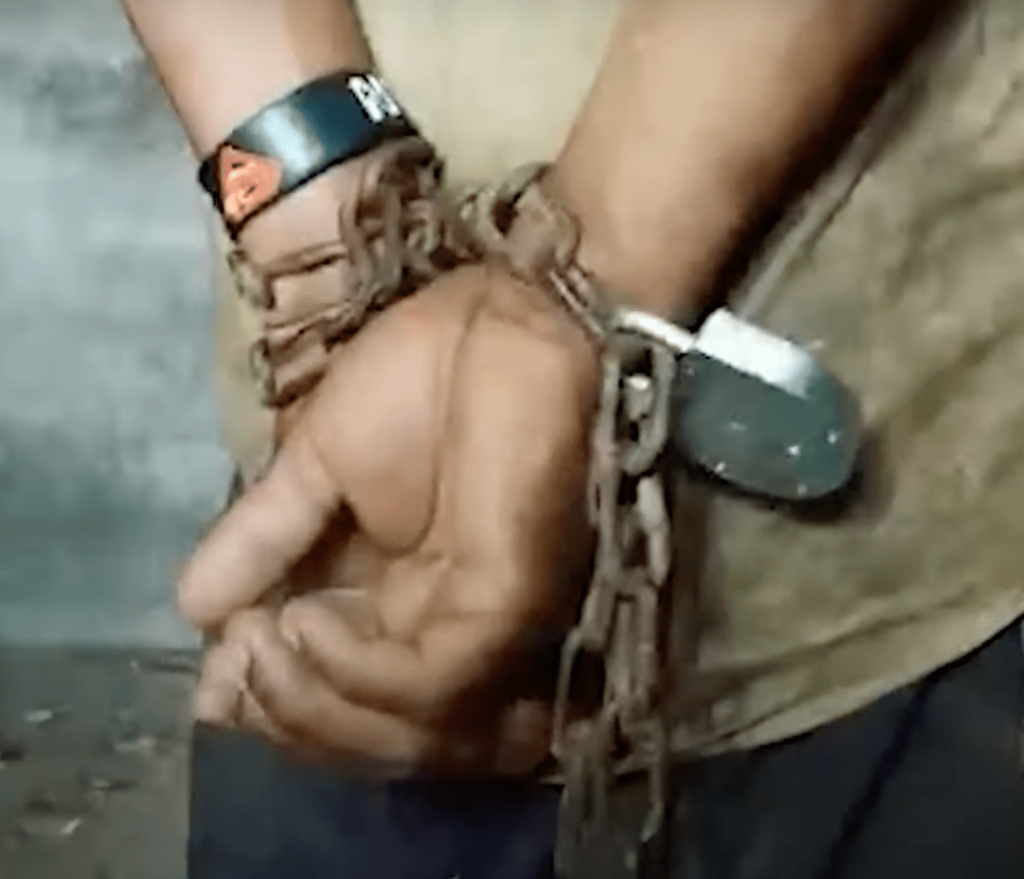
Source: 2021, Bachpan Bachao Andolan
It’s expensive to clean and clear dung. A few people in Punjab have found a workaround — ‘buy’ mentally unstable people for around Rs 10,000-15,000 and force them to work….They are tortured so much that they even forget their village name, and limit their life to feeding cattle and clearing dung. It is a tragedy for Punjab.
Manjot Singh, Guru Aasra Sewa society
2. Organised crime in Canada- The phenomenon is not new, as Punjabis have been involved in organised crime in Canada since the 1990s, primarily in the drug trade. It can be an individual piece of its own if we try to write about it. Interested readers can try looking up on the internet for these names to know more about it: Sanghera Crime Family, The Ruffians (formed by Punjabi students), Malli-Buttar Coalition, Independent Soldiers Gang, Brothers Keepers Gang, Kang Crime Group, and Punjabi Mafia.
3. Verbal and physical assaults by separatists-
Here, we will provide examples that will give a gist to this problem.
If you will call Saint Bhindrawale a terrorist, then we will call your Hanuman as the world’s first international terrorist. [crowd cheers]
A khalistani calls lord Hanuman 'first international terrorist' as other khalistanis cheer the hate speech against Hindus. pic.twitter.com/Sf7EWbNWFr
— Newsum (@Newsumindia) March 27, 2023
But examples of verbal assaults or attacks on temples cannot be taken as the benchmark to gauge what is going on inside the country.
But is the situation inside the country any different?
While the chopping habits are continuously put on display by Nihang Sikhs. The freshest memory on top of my mind would be the chopping off the hand of a police constable.
It would have been still understandable, definitely not allowed under rule of law, yet understandable that the warrior genes of Nihang Sikhs don’t find enough opportunities for expression outside some public shows. Also, even if it is in the country, citing instances from Sikhs cannot mean that conclusions about culture can be made.
What is appalling is that these chopping habits have percolated in Punjabi Hindus as well. Watch.
Many examples of this chopping habit can be found over the internet and if one is free then a few hours on the NCRB website can provide more instances including those that never made it to the internet.
So where does Punjab stand today?
When it comes to resources, no other state comes even near to Punjab. The land of five rivers, that has it in its state policy not to share its river with other Indian states [article]. A land that has the most fertile soil but also consumes more pesticides per hectare than any other Indian state [link to study]. A land which brags about its warriors supposedly protecting their women from foreign invaders, but also has the lowest conviction rate for crime against women [link]. The rich state of India doesn’t even come in the top 15 contributors to national GDP.
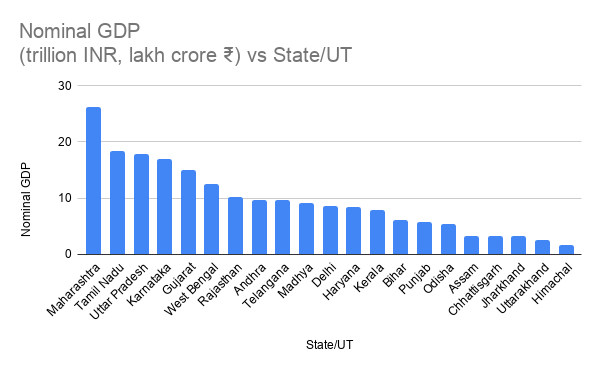
It comes as no surprise that these results are the logical culmination of a culture that, regardless of resources, could never thrive unless it reflects on its problem. Supporting separatist sentiments could never bring prosperity.
But what about the silent majority that doesn’t want a different nation?
Like our readers, we too didn’t want to see everyone with the same glass. But it will be foolish to not see the obvious. Artists and celebrities of Punjab get their bread from Punjabis. Is it wise to ignore the posts of cricketers like Harpreet Brar and Harbhajan Singh praising Bhindrawale, venomous words by separatist poster boy Diljit Dosanjh, or auto-tune singers like Kanwar Grewal calling terrorists as Sant, or Shubh sharing a distorted map of India? Unlike celebrities from the rest of India, Punjabi celebrities never get cancelled.
Is it wise to ignore the sitting member of parliament of India that openly calls for a separate nation and gets more than 2.5 lakh votes out of the total 7 lakh votes? And this is not the first time that he won. From his first time election in 1989 where he secured a landslide victory by getting 88% of the total votes, Simranjit Singh Mann was very clear about his narrative. How do we convince ourselves that the voters did not know this?
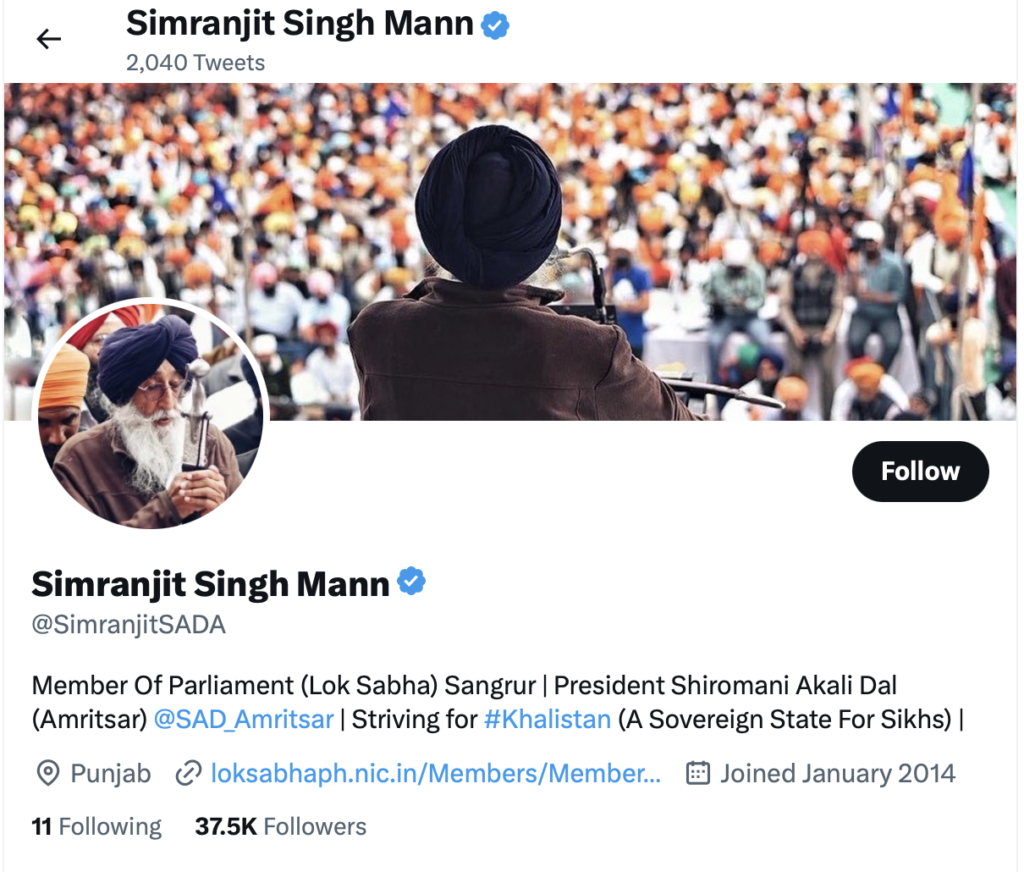
What about all those who very stoutly reject the idea of separatism on the internet?
We don’t have enough material to refute all the posts against this separatist narrative. However, we did our own analysis. From the trending hashtags on Twitter, the top three were chosen #RealSikhsAgainstKhalistan, #SikhsRejectKhalistan and #RealSikhs.
The origin accounts of these tweets turned out to be fake. We identified as many as 20 fake accounts on Twitter with a total of more than 60,000 followers. All profiles had names similar as XYZ Kaur and profile pictures were taken from other lesser-known influencers. The same username could be traced for the carbon copy accounts on Instagram and Facebook.
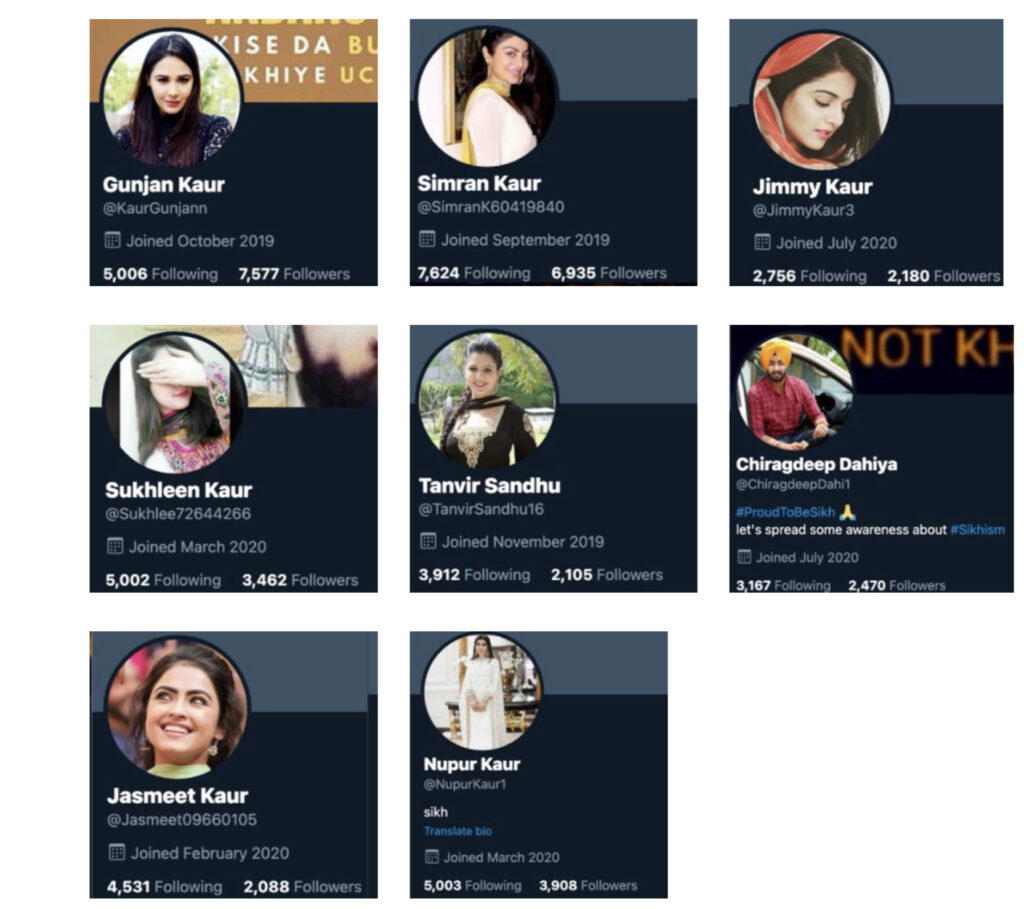
The tweets were distributed to regions such as South of India and Gujarat as well making it even harder to trust.
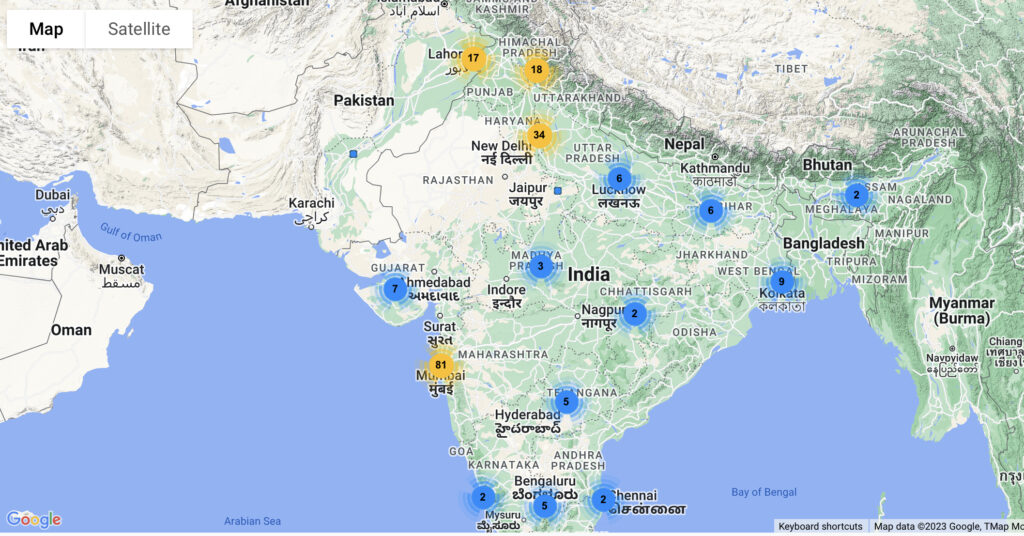
A simple word cloud analysis of the accounts following them gave keywords like proud-indian-hindu-love-india-jai-nationalist, it is a well-known fact that IT cells use accounts with these keywords to amplify their required hashtags.
If anyone of our readers is interested in the methodology of our analysis, we encourage an email for the same. Sanely Written will send a step-by-step guide to how similar network analysis can be done.
While we have direct signs of Punjabis supporting the separatist cause, the counter of this cause is blotted with such fake injected trends.
It is time to recollect our thoughts. Till now, we have seen the first part of the dissection – Sikhs and the problem itself. It is now time to see the other part of the dissection that is the backbone of this problem – Punjabi Hindus.
THE HINDUS
History and its direct implication on the Present
We cannot bring ourselves to write about the present without writing about the past. The distinction between a Punjabi Hindu and a Sikh has not always been so clear. The pre-partition Punjab was inhabited by people who were syncretic. The ethnic construction of a Punjabi as it now stands is a strong testament that modern Sikhism (one half of the division) is rather a very new and colonial construct [discussed above as well with different arguments].
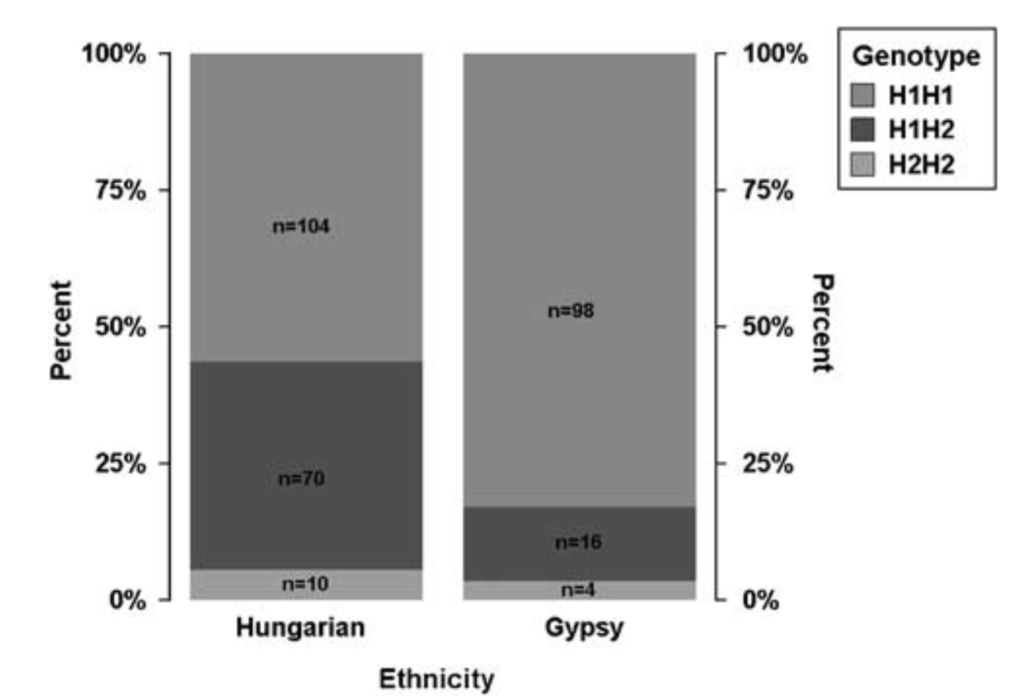
A study of H1 tau haplotype-related genomic variation suggests that Gypsies migrated from the Punjab region 1000– 1500 years ago [link to study]. This makes the Punjabis the ancestors of the Gypsies. Without any support, we leave the perception of Gypsies in Europe is of criminals, pickpockets, and beggars who are not interested in integrating into the mainstream. We, however, do not subscribe to this claim.
The work of Scottish Commissioner S.S. Thorburn, an ICS officer, gives precise information about the Hindus in the pre-partition Punjab. The main groups were Brahmins, Rajputs, vagrants and traders. There was no sign of harmony either among this group or with the Sikh castes.
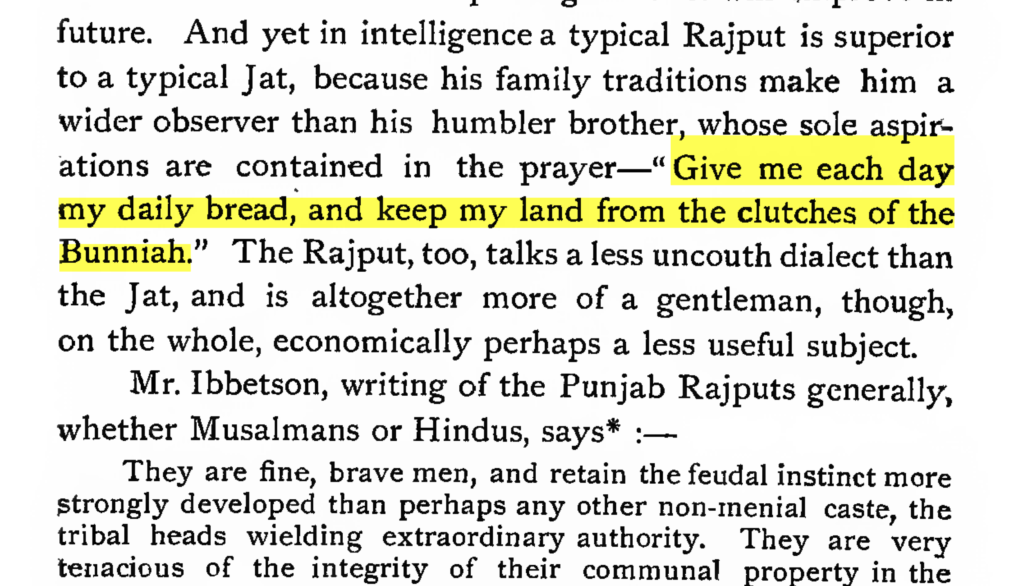
The Brahmins were most numerous in Rawalpindi and were respected for their sacerdotal caste.
The vagrants were the fakirs and the jogis who were on the move but mostly inhabited the Cis-Indus region in the northern table-land.
The traders were the majority among the Hindus. This umbrella term included Aroras, Khatris, Bhatias, and Bunniahs. The British usually remarked that they were governing the lands chiefly to the advantage of the traders, and were thereby jeopardising the stability of their hold on the affections of the people. The reason the traders got such a bad name was not because of the general disliking towards their caste but because of the unobtrusive persistence with which they conducted business. This trait among modern-day Punjabis is one of the contributors to the Punjab problem where business always trumps other important matters like the call of the nation. It is to be noted that Bunniahs or Aroras were not native to Punjab and only settled for business [See the picture below]. This mobile attitude is directly evident in today’s India as well where Punjabi Hindus are found in Delhi (35%), Haryana (30-35%), Jammu, Himachal, and Uttar Pradesh. And the reason for their migration is hardly persecution but business [We will explain it later].
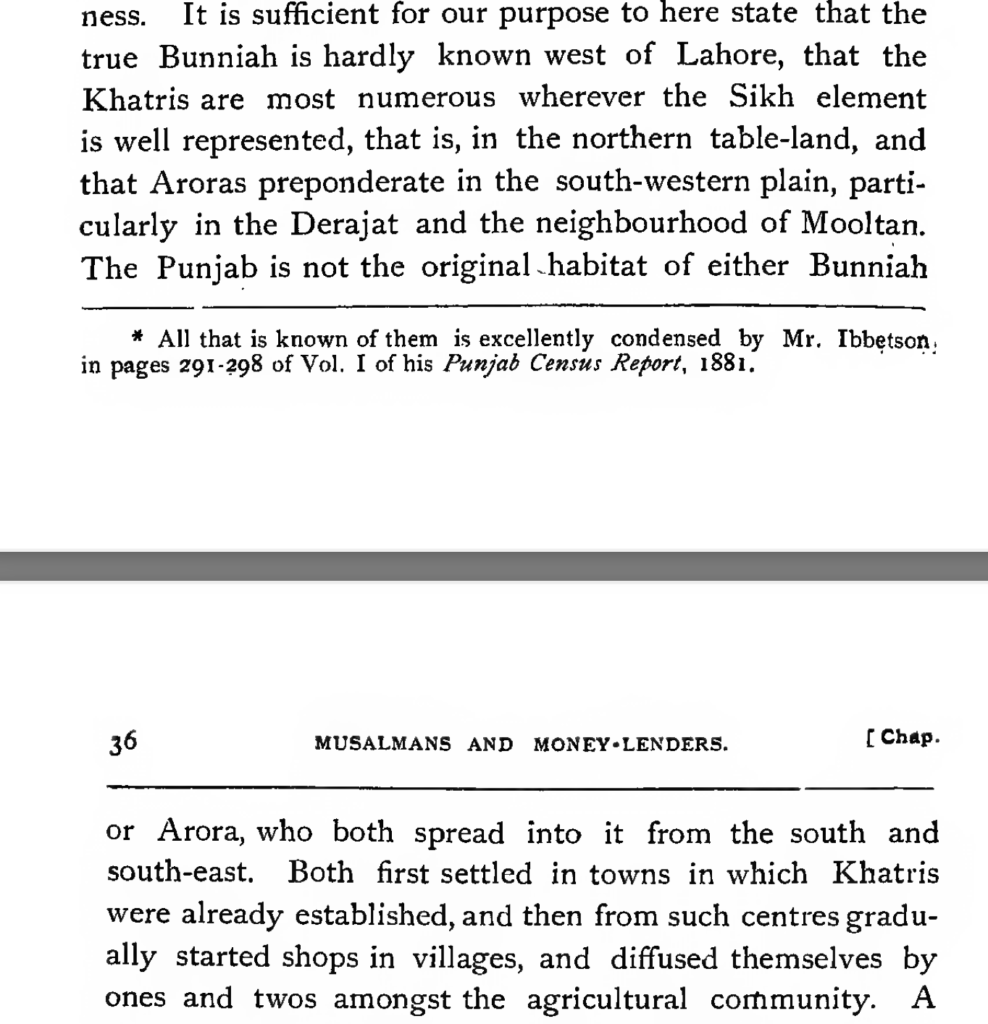
The curious case of Punjabi Hindus
The 3-4 heinous cases of violence against Hindus in Punjab have been iterated so many times in print and visual media that it is very natural to make an opinion that Hindus suffered under the separatist movement in Punjab. So, we studied all that could be found about the businesses in Punjab during the time of insurgency. We must admit the material is very scarce but what’s available is enough.
While we understand that persecution is a very qualitative issue but there are some metrics that can be seen for analysis purposes.
1. Impression – Hindus were brutally murdered during the insurgency.
A total of 25000 people were killed during the insurgency in Punjab. Surprisingly, the exact figures for the number of Hindu deaths have not been recorded anywhere. In our own estimates [labour of going through all reported numbers of deaths on internet archives], this number is around 5000. However, we are ready to accept vague claims of equal deaths [link] on both sides.
2. Impression – Punjabi Hindus faced persecution during the insurgency.
While it is true that Brahmins were forced to leave Punjab during the insurgency mainly because they refused to comply with the idea of separatism. But the majority of Hindus who owned businesses stayed and in fact, enjoyed growth.
In a study of 3 villages of Amritsar: Butala, Mattewal and Naushera Pannuan, all known for peak insurgency and a Sikh population above 80%, it was found that around 60% of entrepreneurs were Hindus.
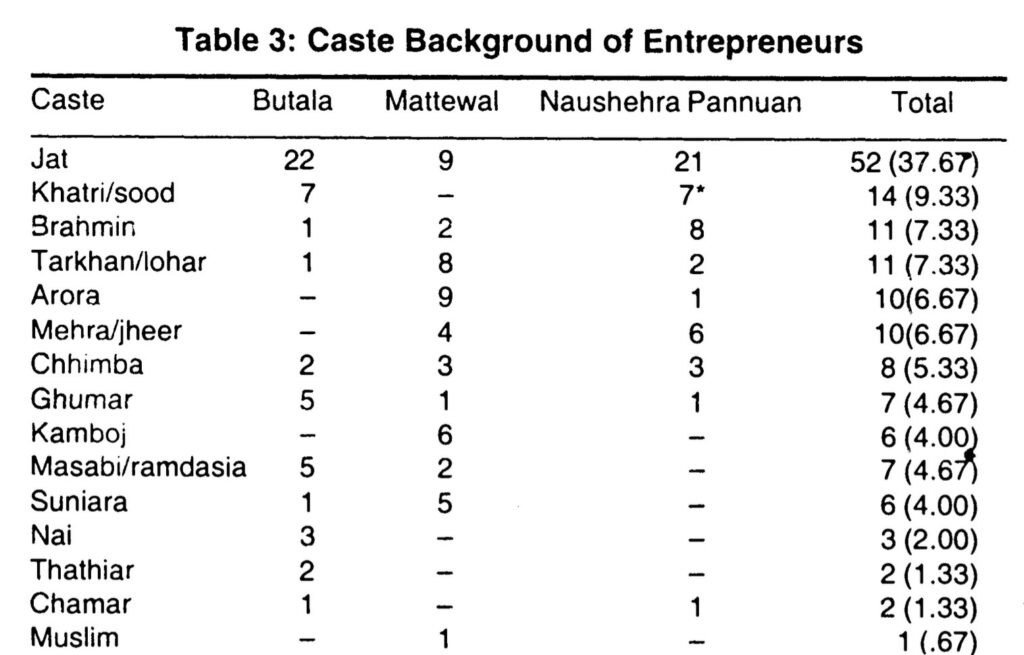
As often done with Sikhs, the blame of the separatist movement does not singly fall on them. One should drop the prism of religion and see facts as they are. As it happens with any separatist movement, the only people who suffer are those who fail to comply with the ideas of militants. The same study shows the transaction of properties during the insurgency. On one side where Jats and Brahmins were forced to relocate after selling their properties, the Hindu business class faced no persecution.

These were direct empirical evidence that show that Punjabi Hindus are not victims but beneficiaries of the separatist movement providing everything from money to weapons to the militants.
A different logic for the same deduction
The Holocaust and the Exodus of Kashmiri Pandits are two devastating examples of persecution faced by those who do not comply with separatist ideologies. The Holocaust saw millions of Jews targeted and killed under Nazi rule, with their identity and humanity cruelly stripped away. Similarly, the Exodus of Kashmiri Pandits forced them to flee their homeland, leaving behind their homes and hearths. Both events serve as reminders that when ideas of separatism take hold, those who do not comply become the target, with their lives and livelihoods torn apart. Typically, all insurgencies function with this idea. A caste or a religion being entirely targeted is just a part of the process.
We who have come back, by the aid of many lucky chances or miracles – whatever one may choose to call them – we know: the best of us did not return.
Man’s Search for Meaning, Viktor E. Frankl writing about Jew’s experience in concentration camps.
The fact that Punjabi Hindus thrived in the peak of militancy while being at the epicentre and that Punjabi Hindus are included in all forms of ideas of a separate state only solidifies their compliance by prioritising business over anything, even their culture.
But is it moral to make such outrageous claims about the whole culture?
No. It is immoral. It is as immoral as calling a spade, a spade.
Ethnic Amnesia among Punjabi Hindus
Two things have to be taken into account about Punjabi Hindus:
1. The primordial identities of shared religion, language, and region have been as flaky as the imagined ascription of citizenship and nationality.
2. They disassociate themselves from their identity only when it helps their business.
This attempt at new identity-making was studied in detail by Ravinder Kaur in his Oxford-published book ‘Since 1947: Partition Narratives among Punjabi Migrants of Delhi’.
The children of the Punjabi migrants are only taught the languages which will be useful.
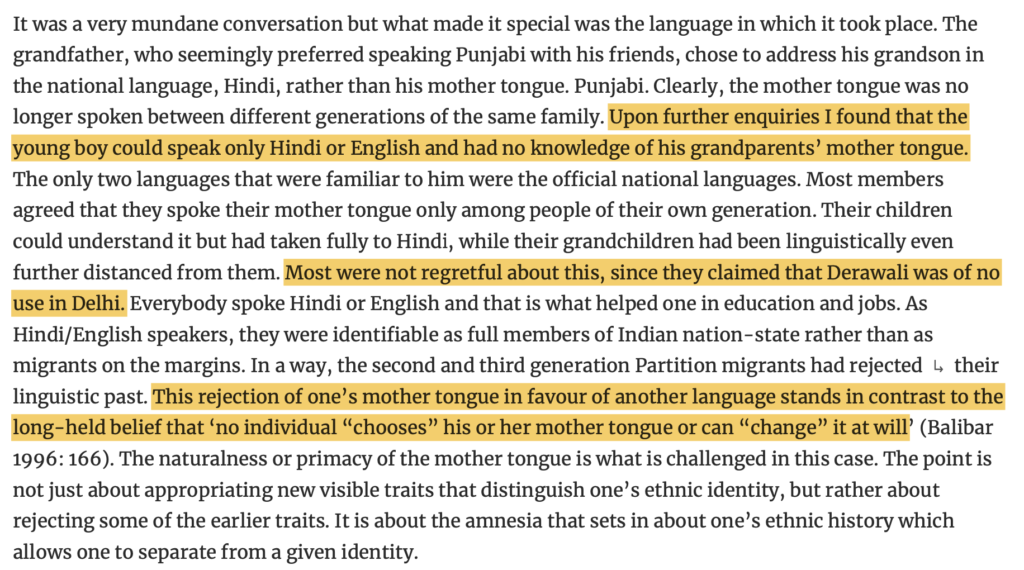
So we have talked about the nature of Punjabi Hindus in and out of Punjab. But these are studies by people who are not Punjabi Hindus themselves. Well, we did come across another book by a Punjabi Hindu writing in his field notes about the other migrant Punjabi Hindus.
Are Punjabi Hindus from nowhere?
A few snaps from the book ‘Where are you from?’ by Punjabi anthropologist Dhooleka S. Raj.
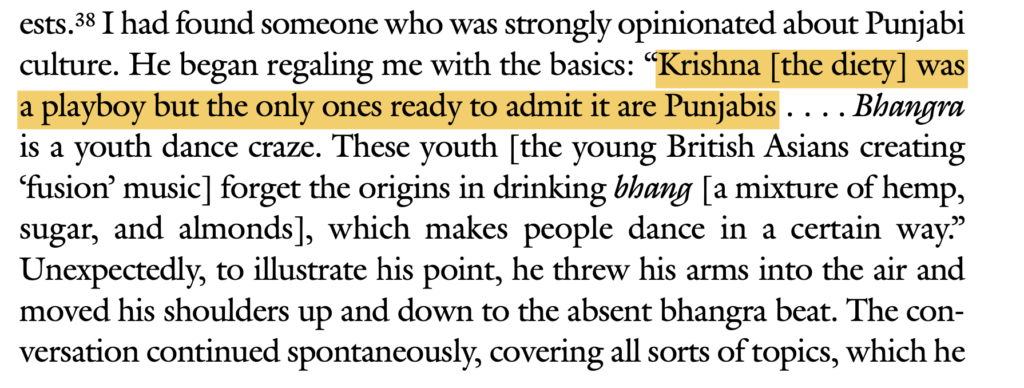
In an attempt to interview more Punjabi Hindus, the author befriends four Punjabi Hindu families in London Aggarwals, Chawlas, Kalias, and Kapurs.
Here is what one of those people (Uncle Aggarwal) says about showing the Gujaratis and Bengalis out of their Punjabi Hindu temple.
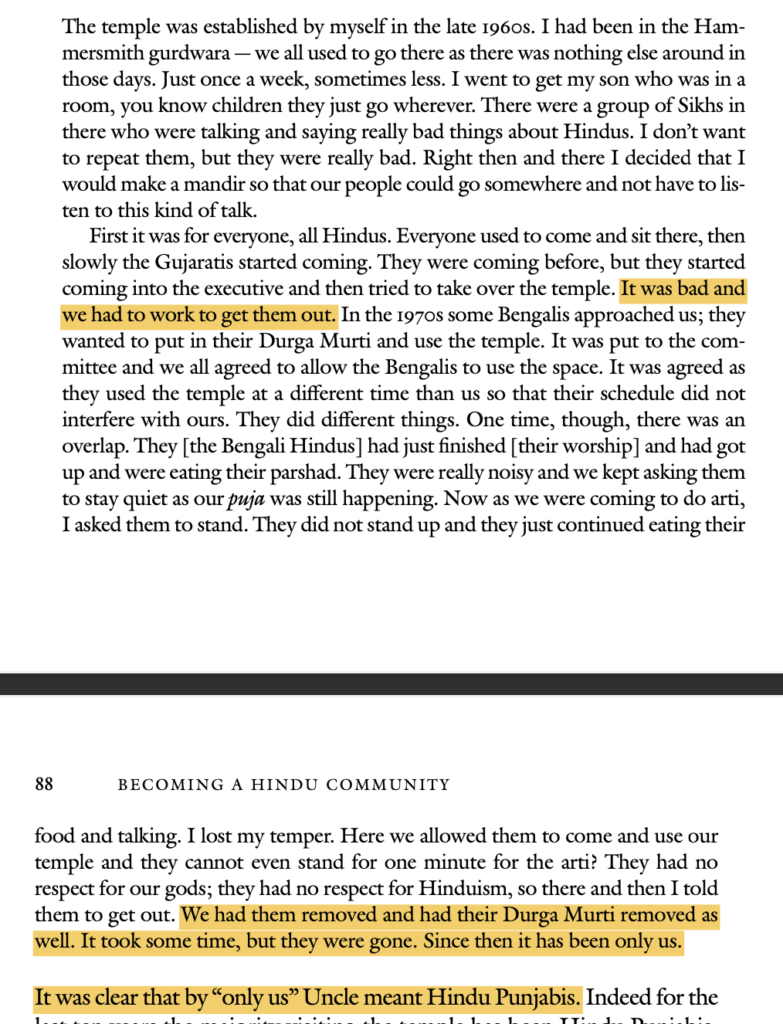
The following solidifies our point that there was no distinct boundary between the Sikhs and Hindus in the past. Only the identity of being a Punjabi was paramount. And this mentality still trumps religious consciousness.
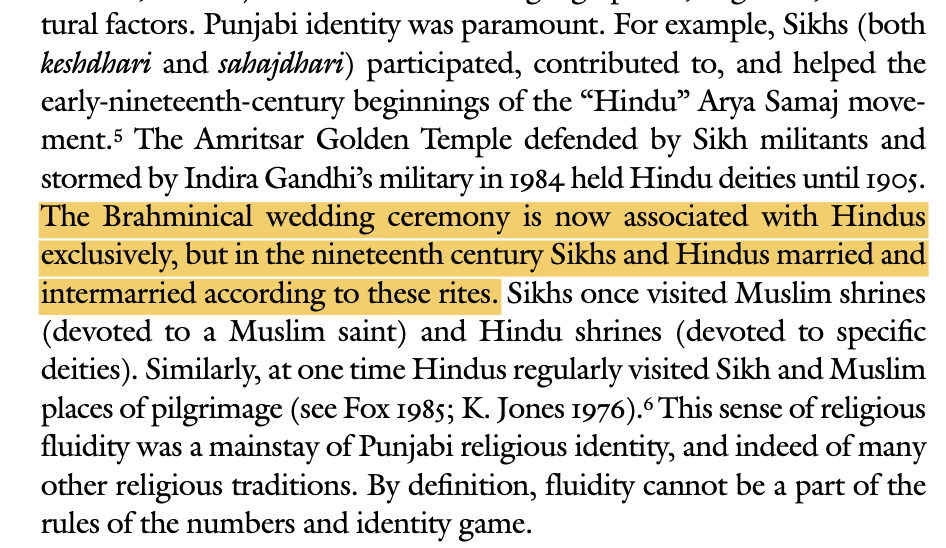
This snapshot provides a vision of how the way of referring states east of Punjab as Hindustan meant that it was the land of Hindus but not a home for Punjabis. This pre-partition terminology is often visible even today when the central government is called ‘Dilli Durbar’, a term that Punjabis used during Mughal rule.
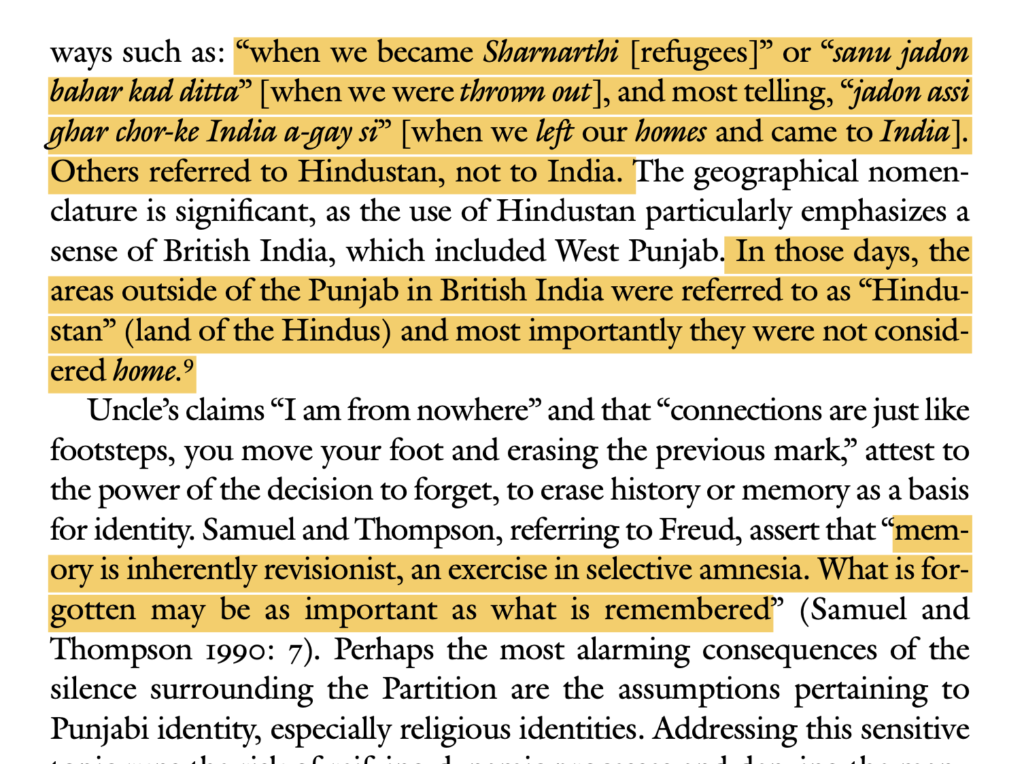
This still does not leave us with a definitive response. But we hope this will come across to our readers as a genuine attempt to decipher the enigma of the problems of Punjab rather than the problems in Punjab. As we delved deeper into the realities of Punjab, it became clear that the state is facing a myriad of challenges that comes from its own culture.
We must understand that the state is facing some serious issues, and there is no hope for a better future until these problems are attributed to their right cause.

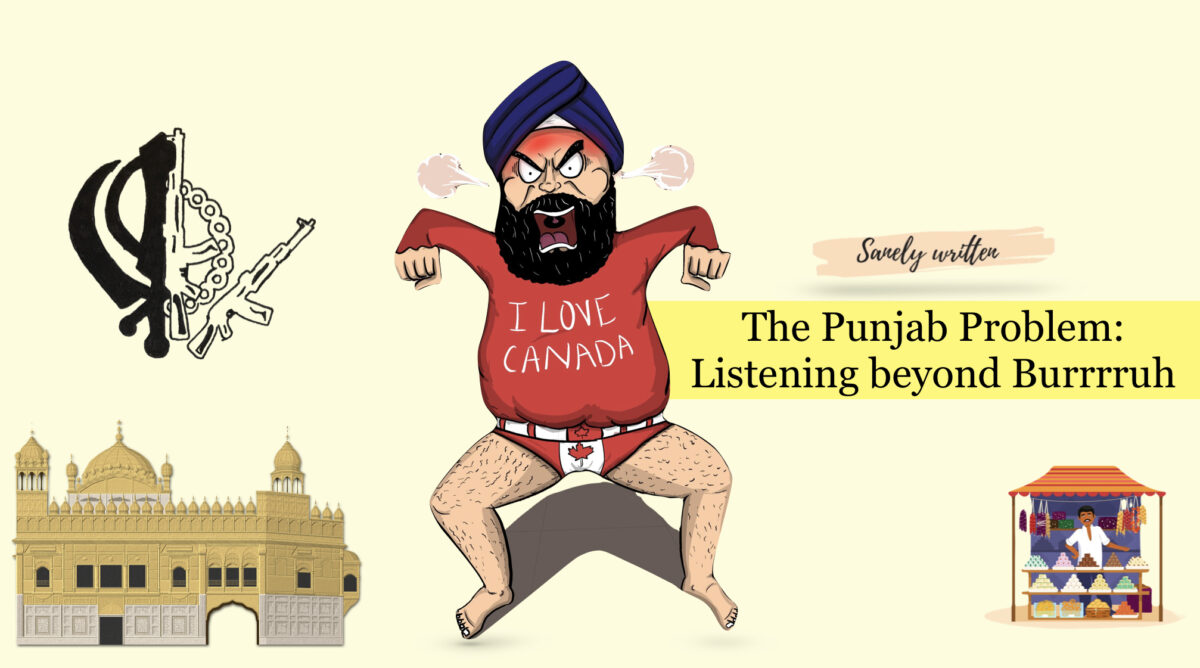
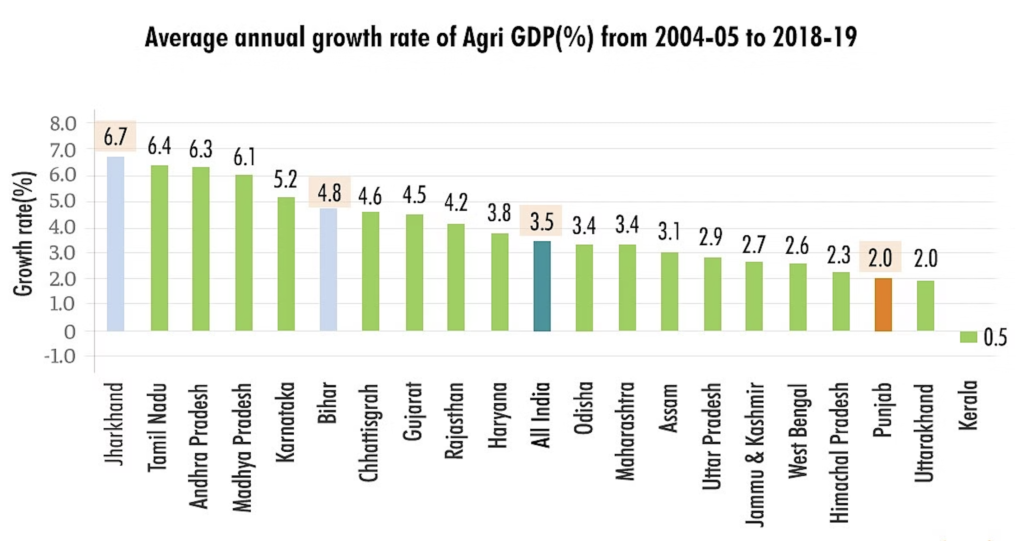
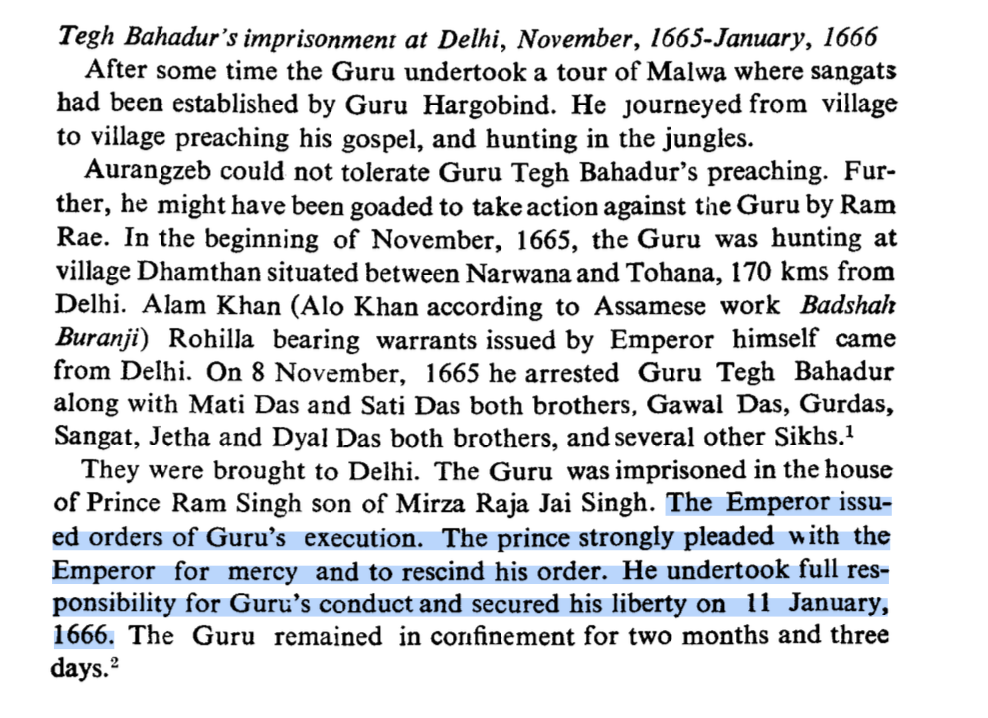
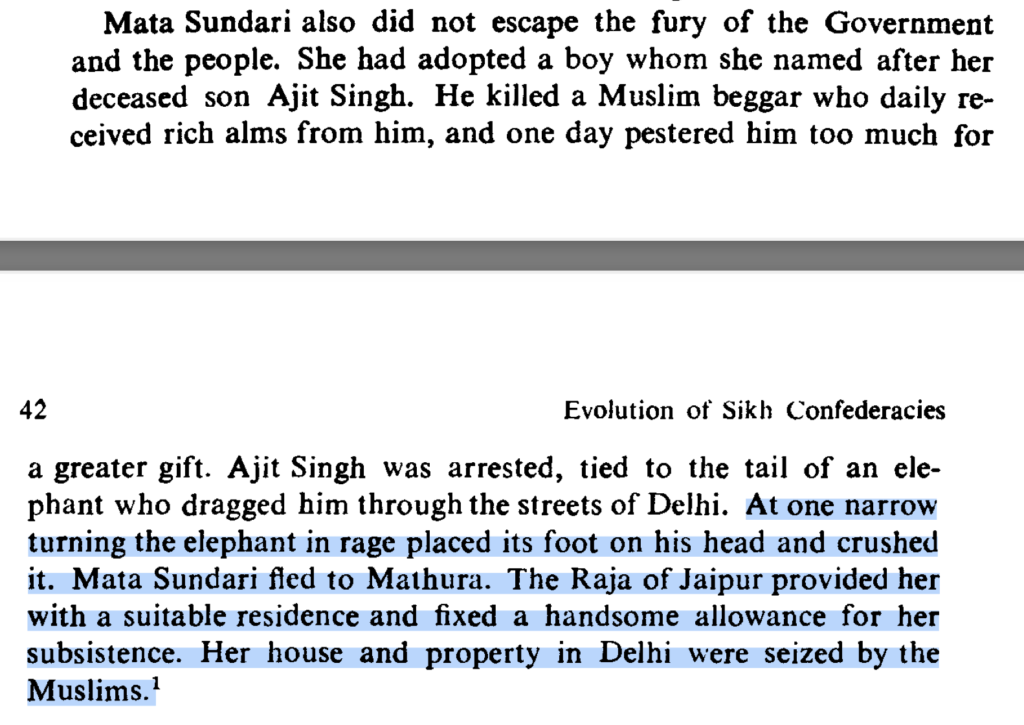
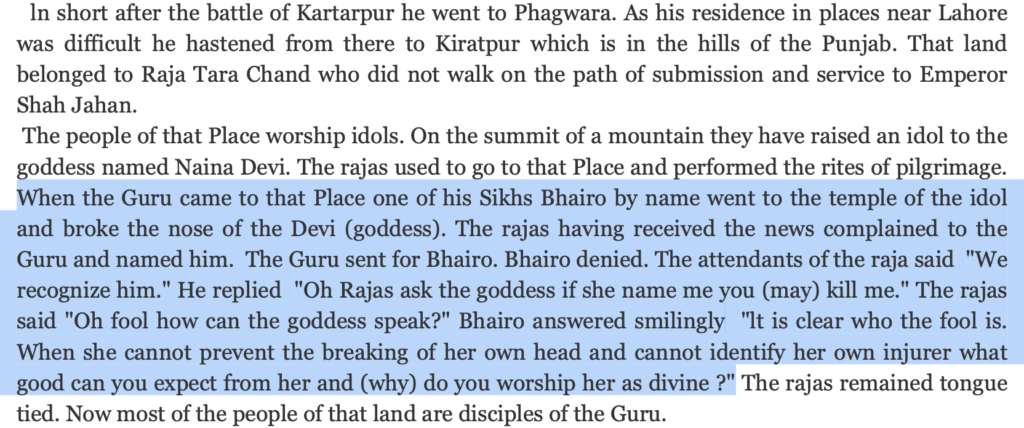
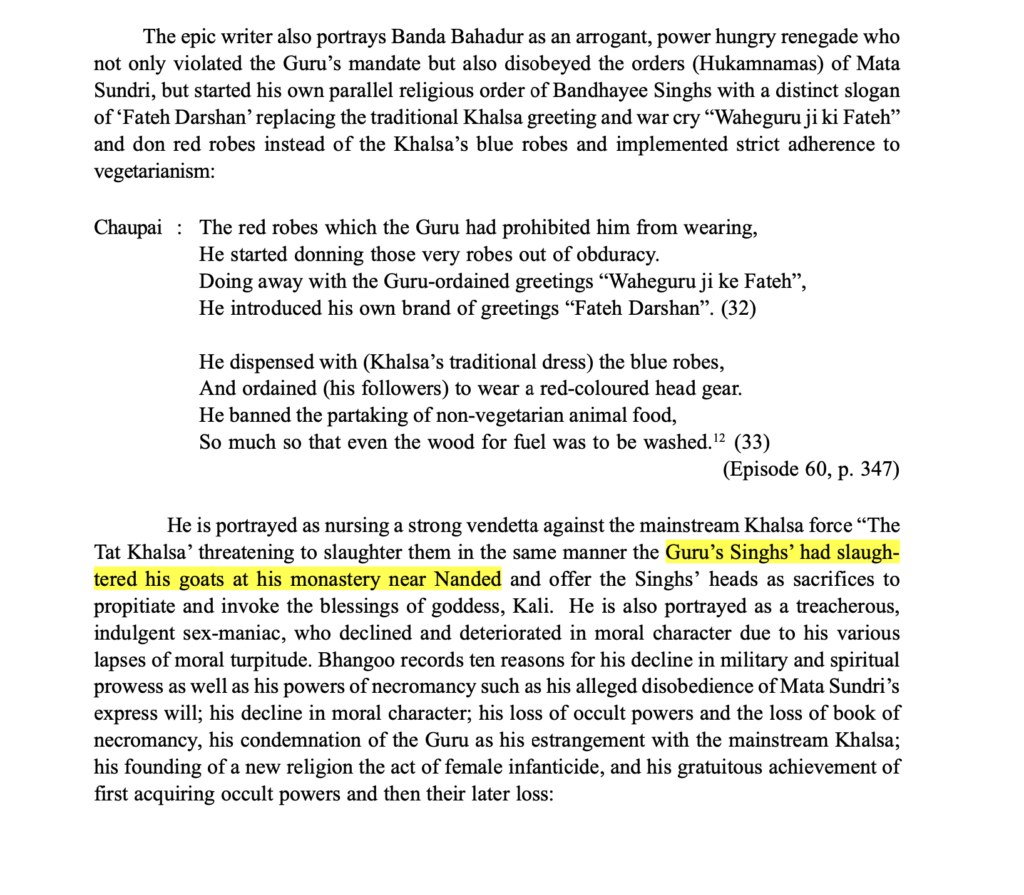
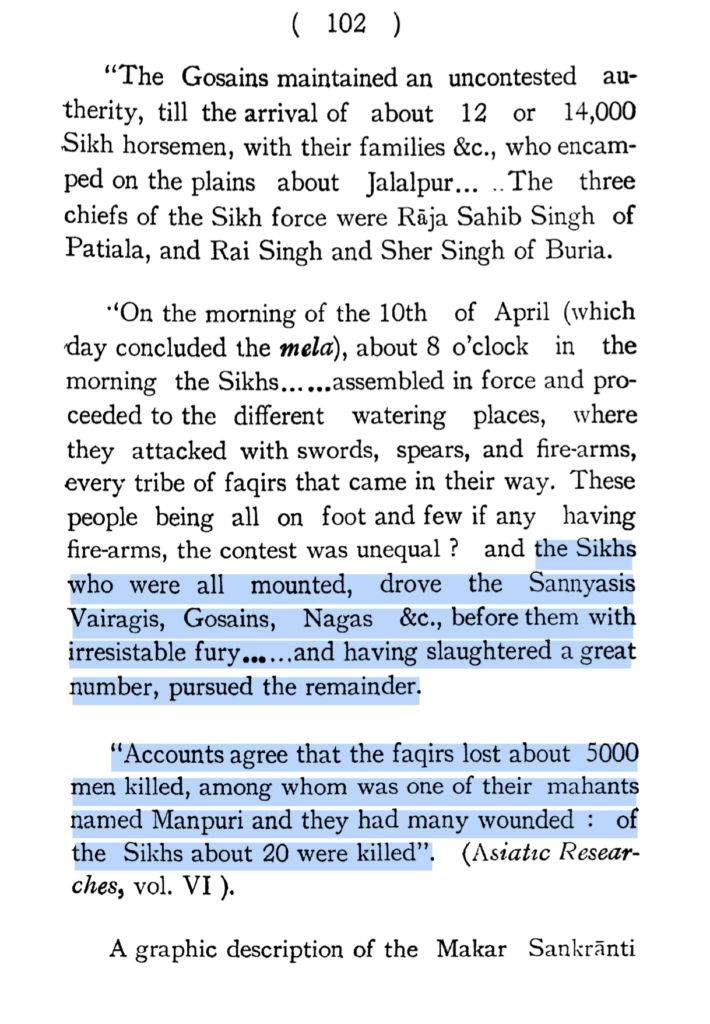
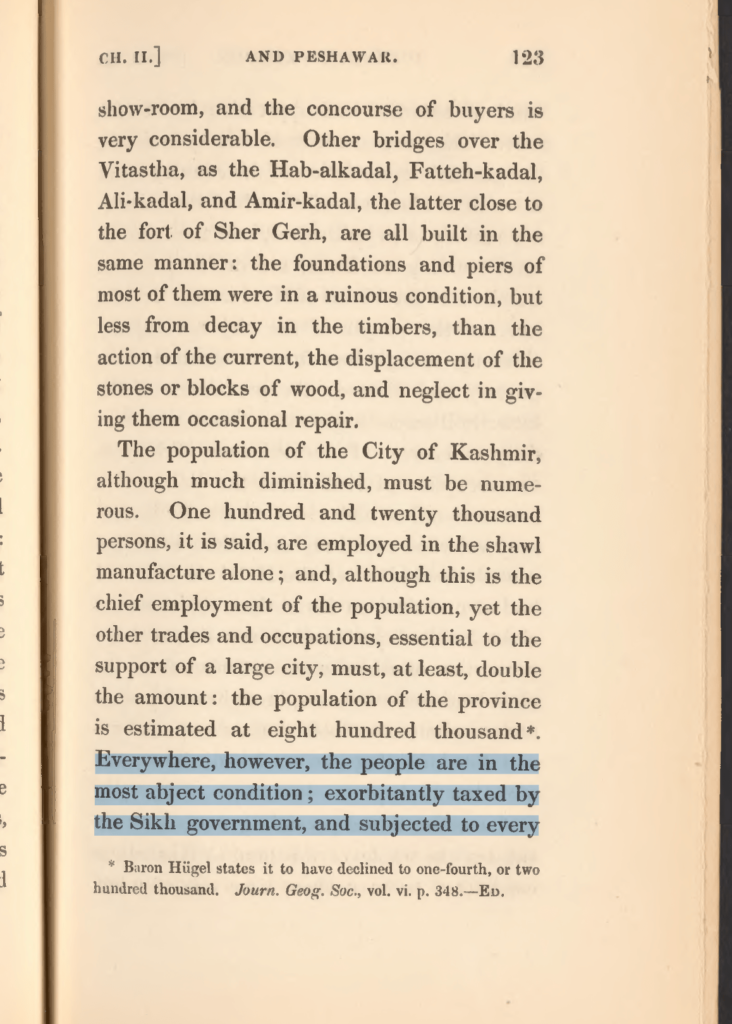
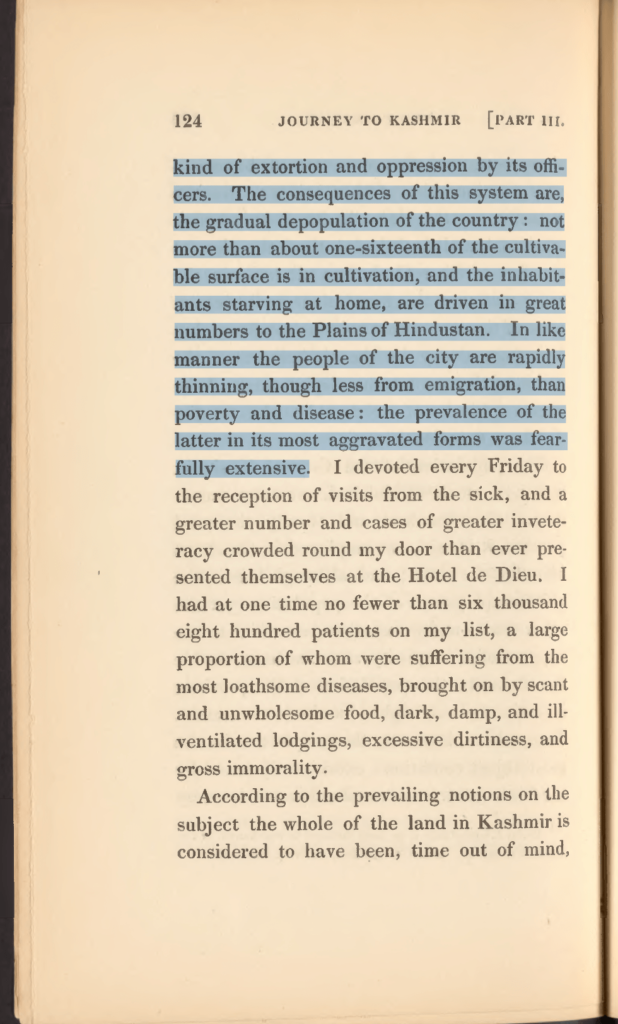
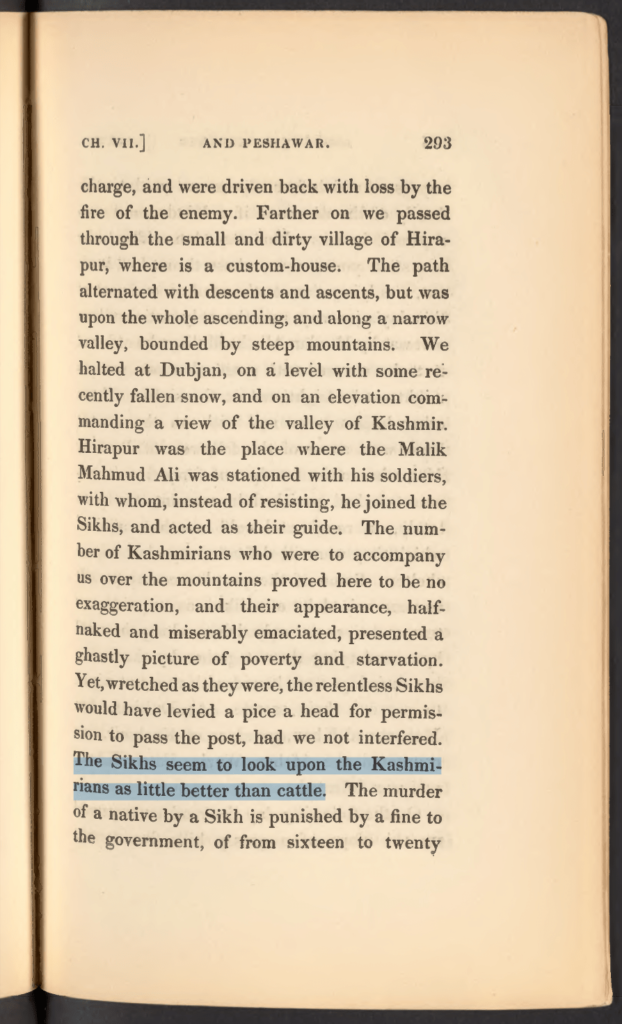
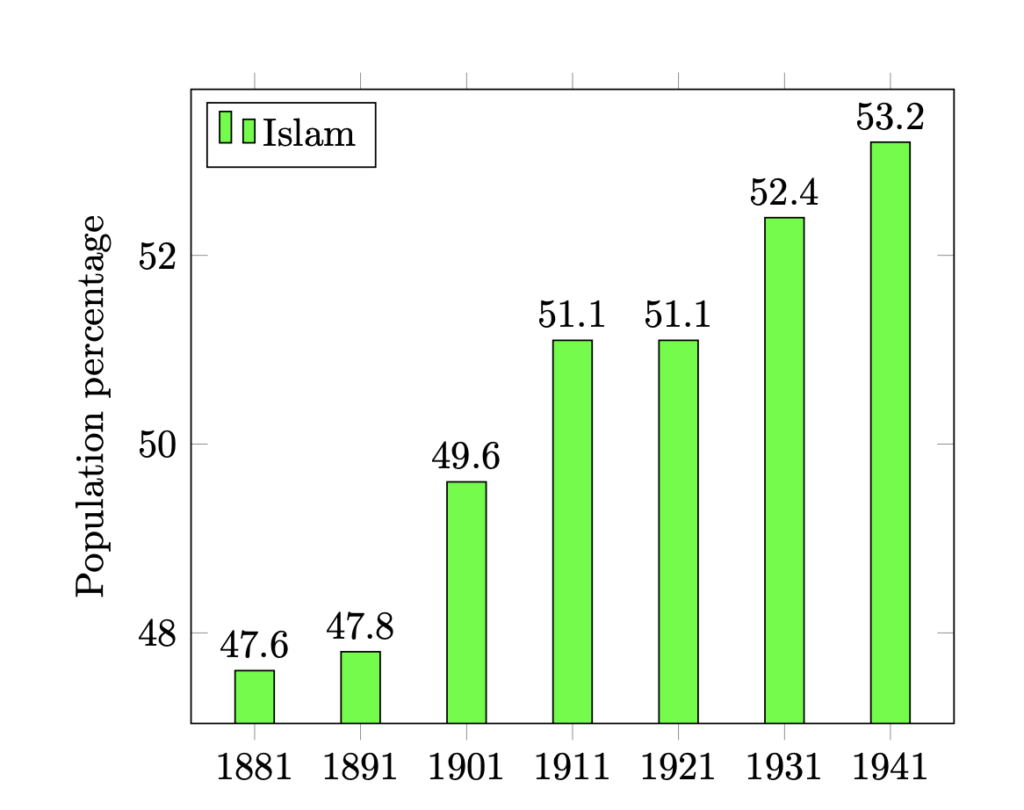
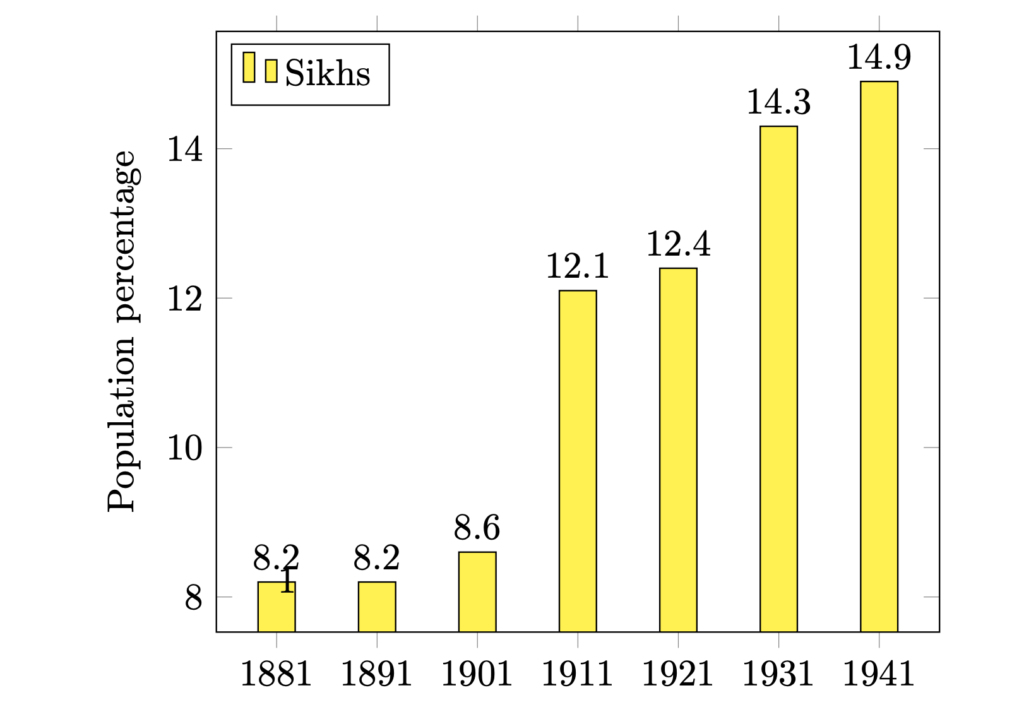
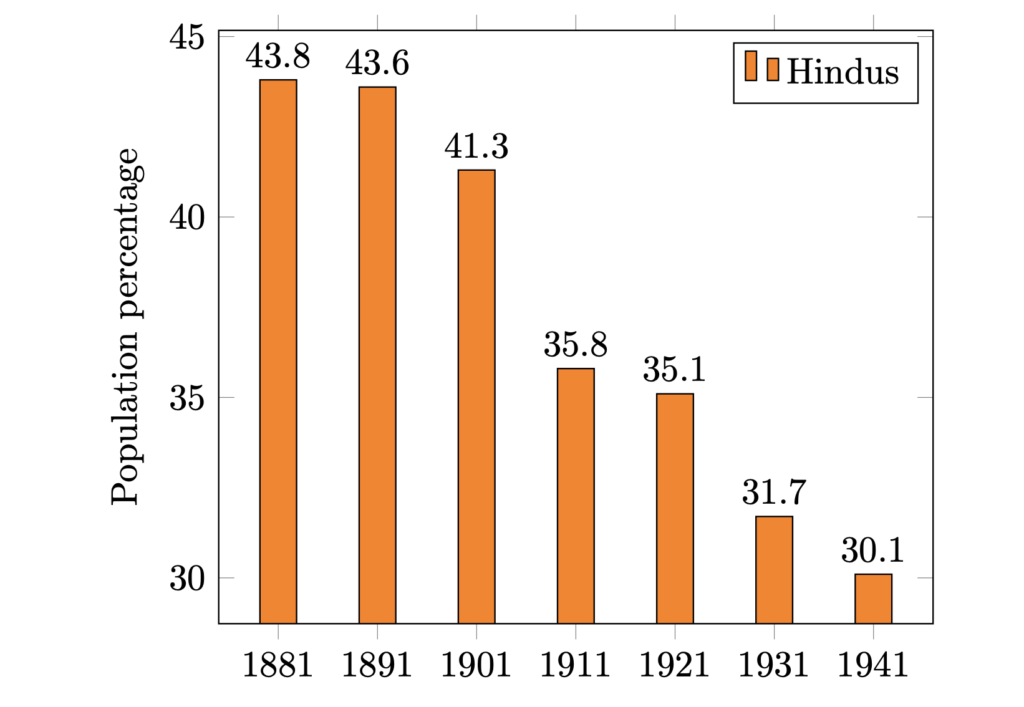


2 replies on “The Punjab Problem: Listening beyond Burrrruh : Part 2”
👍
Coming from a “SOURCE” getting into a rule based routine, then on considering one self Better / Pure, seeing down the “SOURCE” as impure / disgusting
One sees the above attitude In Civil Services etc etc
Like In Army once recruited from the masses lateron seeing the mass as “Civilian” implying Alien n impure but recruit will not stop as it does not create a new sect.
UNFORTUNATELY the “Hindu/Sanatanis” the Source where-from the “Sikhs” came No longer Contributes to its Number
Late Marriage Low BirthRate Assimilation by Christanity and iSlam – Sikhs as a race is way past its peak and now will be a dying race
I Give it 200 years for a total wash away from History and except Handful of Scholars No one will know Sikhs Existed between 16th to 21st Century
DeMeaning the Sanatan Dieties in favour of a Live Guru and then Terming the “Book”[A Symbol none the same] as the Guru was a con that took in many simple minded Sanatanis
NO MORE NOW